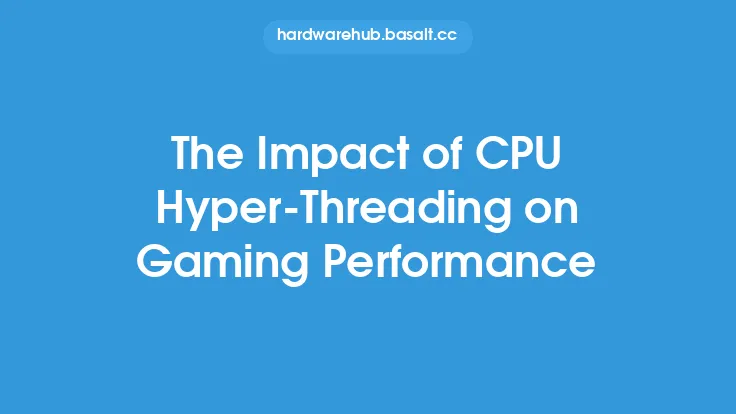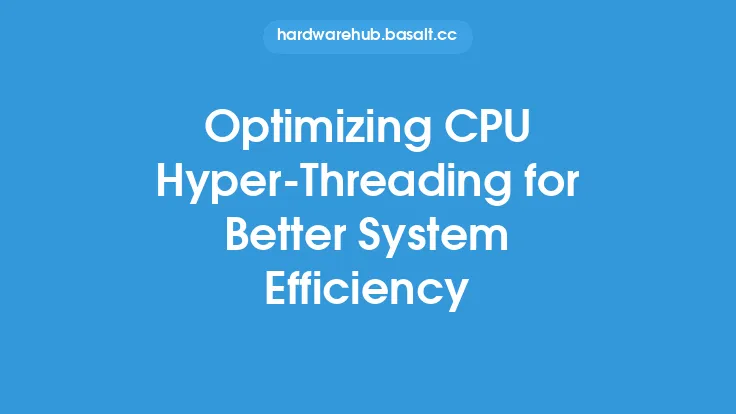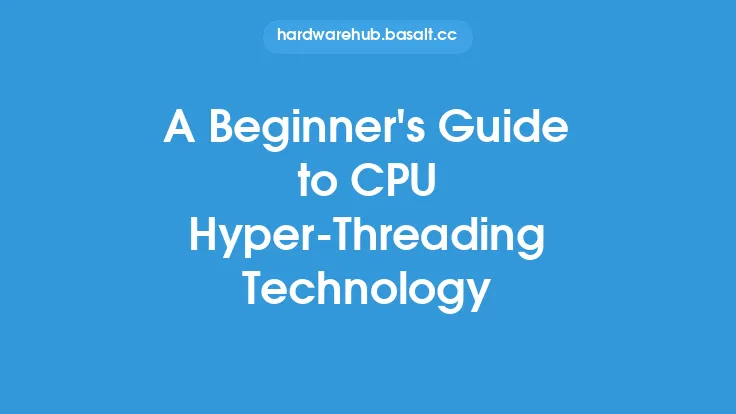The concept of CPU hyper-threading has been a significant advancement in the field of computer architecture, allowing for improved system performance and increased productivity. By enabling a single physical core to handle multiple threads simultaneously, hyper-threading technology has revolutionized the way we approach multitasking and computational tasks. In this article, we will delve into the details of how CPU hyper-threading enhances system performance, exploring the technical aspects and benefits of this technology.
Introduction to Hyper-Threading
Hyper-threading, also known as simultaneous multithreading (SMT), is a technique used in computer architecture to improve the performance of multi-threaded applications. By allowing a single physical core to handle multiple threads, hyper-threading enables the efficient use of resources, reducing idle time and increasing overall system throughput. This technology is particularly useful in scenarios where multiple applications are running concurrently, such as in web servers, databases, and scientific simulations.
Technical Aspects of Hyper-Threading
To understand how hyper-threading enhances system performance, it's essential to explore the technical aspects of this technology. In a traditional single-threaded processor, the core executes a single thread at a time, with the execution pipeline handling one instruction at a time. In contrast, a hyper-threaded processor can execute multiple threads simultaneously, with each thread having its own program counter, registers, and execution pipeline. This allows the processor to switch between threads quickly, reducing the overhead associated with context switching.
The key to hyper-threading is the ability of the processor to manage multiple threads concurrently, using a technique called thread scheduling. The thread scheduler is responsible for allocating resources, such as execution pipelines and registers, to each thread. By dynamically allocating resources, the scheduler can optimize the execution of threads, minimizing idle time and maximizing system throughput.
Benefits of Hyper-Threading for System Performance
The benefits of hyper-threading for system performance are numerous. By enabling a single physical core to handle multiple threads, hyper-threading can:
- Increase system throughput: By executing multiple threads simultaneously, hyper-threading can increase the overall throughput of the system, allowing for more tasks to be completed in a given time frame.
- Reduce idle time: Hyper-threading reduces idle time by allowing the processor to switch between threads quickly, minimizing the time spent waiting for I/O operations to complete.
- Improve responsiveness: By executing multiple threads concurrently, hyper-threading can improve the responsiveness of the system, allowing for faster execution of tasks and improved user experience.
- Enhance multitasking: Hyper-threading is particularly useful in scenarios where multiple applications are running concurrently, such as in web servers, databases, and scientific simulations.
Hyper-Threading in Modern CPUs
Modern CPUs have incorporated hyper-threading technology to improve system performance. For example, Intel's Core i7 and i9 processors feature hyper-threading, allowing for up to 18 threads to be executed simultaneously. Similarly, AMD's Ryzen and EPYC processors also feature hyper-threading, with some models supporting up to 64 threads.
In addition to desktop and server processors, hyper-threading is also used in mobile devices, such as smartphones and tablets. By enabling multiple threads to be executed concurrently, hyper-threading can improve the performance of mobile devices, allowing for faster execution of tasks and improved user experience.
Challenges and Limitations of Hyper-Threading
While hyper-threading offers numerous benefits for system performance, there are also challenges and limitations associated with this technology. One of the primary challenges is the increased complexity of the processor architecture, which can lead to increased power consumption and heat generation.
Another limitation of hyper-threading is the potential for thread contention, where multiple threads compete for shared resources, such as execution pipelines and registers. This can lead to reduced system performance and increased latency.
Conclusion
In conclusion, CPU hyper-threading is a powerful technology that enhances system performance by enabling a single physical core to handle multiple threads simultaneously. By reducing idle time, increasing system throughput, and improving responsiveness, hyper-threading has revolutionized the way we approach multitasking and computational tasks. While there are challenges and limitations associated with this technology, the benefits of hyper-threading make it an essential feature in modern CPUs. As the demand for high-performance computing continues to grow, hyper-threading will play an increasingly important role in enabling faster and more efficient processing of complex workloads.





